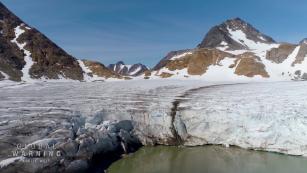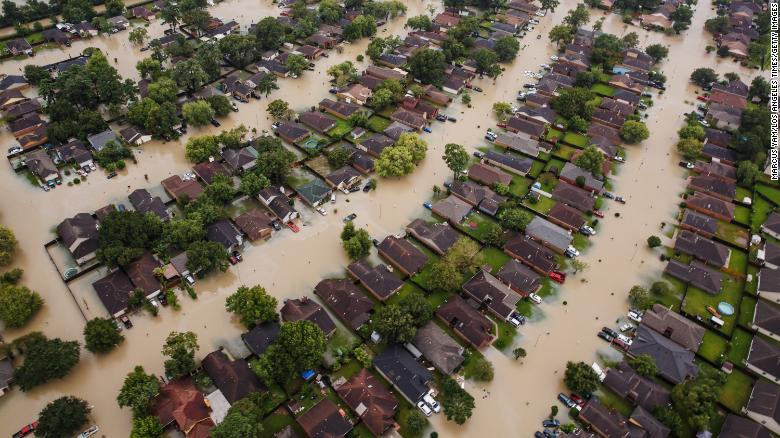Grim report card for planet ranks 2017 one of hottest years in recorded history
(CNN)Last year was one of the hottest in recorded history, according to a new study released Wednesday by the American Meteorological Society.
The report is another piece of compelling evidence that our planet is warming faster than at any point in modern history. It's the 28th version of the annual checkup for the planet and updates numerous global climate indicators such as polar ice, oceans and extreme weather events around the world.
The State of the Climate in 2017 report, led by National Oceanic and Atmospheric Administration's Centers for Environmental Information, was compiled using contributions from more than 500 scientists in more than 60 countries.

Watch the full "Global Warning" special 23:06
The fact that 2017 was either the second- or third-hottest year, depending on the dataset used, does not come as a surprise. It follows a string of record hot years in 2014, 2015 and 2016 -- and while 2017 did not provide a fourth consecutive record, it was the hottest non-El Niño year seen.
El Niño, which is characterized by a warming of the equatorial Pacific Ocean, tends to warm up the entire planet during years when it occurs.
Conversely, when La Niña is active, it tends to provide some natural air-conditioning for the planet as large portions of the Pacific Ocean cool to below average temperatures. Even though 2017 had a weak La Niña present in the beginning and end of the year, it failed to regulate the planet's high temperature caused by ever-increasing amounts of greenhouse gas concentrations.
Photos: 2017's billion-dollar disasters in photos
South/southeast severe weather – Severe storms stretching from the southern plains to Kentucky caused $2.6-$2.7 billion in damage. Large hail and high winds in Texas, just north of the Dallas metro, caused widespread damage.
Hide Caption
8 of 15
Photos: 2017's billion-dollar disasters in photos
Midwest tornado outbreak – An extensive tornado outbreak and powerful straight-line winds affected many from Kansas to New York in March of 2017. Nearly one million people lost power in Michigan. Overall there were between $2.1 and $2.2 billion in damage estimated across these states.
Hide Caption
9 of 15
Photos: 2017's billion-dollar disasters in photos
Central/southeast tornado outbreak – In March, the second largest tornado outbreak of 2017 spawned 70 tornadoes from the Central US to the Southeast. Six people lost their lives and damages estimated to be nearly $1.8 billion.
Hide Caption
10 of 15
Photos: 2017's billion-dollar disasters in photos
Missouri and Arkansas flooding and central severe weather – More than 15 inches of rain fell over a multi-state region leading to historical levels for multiple rivers in Missouri and Arkansas. Homes, businesses, infrastructure and agriculture were all affected leading up to $1.7 billion in damage and 20 lives lost.
Hide Caption
11 of 15
Photos: 2017's billion-dollar disasters in photos
California flooding – After years of being in severe drought, California saw an intense amount of rainfall that contributed to flooding, landslides, and erosion equaling $1.5 billion in damages. Most notable was the damages to the Oroville Dam spillway which lead to a multi-day evacuation of 188,000 residents.
Hide Caption
12 of 15
Photos: 2017's billion-dollar disasters in photos
Midwest severe weather – Two separate Midwest storms each contributed over a billion dollars in damages in June. One caused $1.4 billion of damage due to straight-line winds, hail and more than a dozen tornadoes in Iowa and Nebraska. Another series of storms from Wyoming to New York contributed at least $1.5 billion of damage due to similar conditions, severe winds, tornadoes and destructive hail.
Hide Caption
13 of 15
Photos: 2017's billion-dollar disasters in photos
Southern tornado outbreak and western storms – A violent storm system moved across the US in January. After damaging winds in southern California, the storm produced the third most tornadoes ever in a winter month. From Texas to Georgia, 79 confirmed tornadoes killed 24 and generated $1.1 billion in damages.
Hide Caption
14 of 15
Photos: 2017's billion-dollar disasters in photos
Southeast freeze – It is not unheard of to have a freeze during March in the south, but what made this freeze different were the three weeks of unseasonably warm weather before it. Because of this warm weather, the southern crops had already bloomed and when the temperature got below freezing, it killed many of the peach, blueberry, strawberry and apple crops.
Hide Caption
15 of 15

Photos: 2017's billion-dollar disasters in photos
Hurricane Harvey – The hurricane hit Texas around 11 p.m. ET on Friday, August 25, between Port Aransas and Port O'Connor. The Category 4 storm became a Category 1 by late Saturday morning, packing winds of 75 mph before Harvey stalled dropping trillions of gallons of rain over Texas. Harvey busted the US record for rainfall from a single storm, dumping 51 inches of rain in parts of Texas flooding much of the Houston Metro for days.











